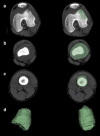Machine learning-based CT radiomics features for the prediction of pulmonary metastasis in osteosarcoma
- PMID: 34111978
- PMCID: PMC8764920
- DOI: 10.1259/bjr.20201391
Machine learning-based CT radiomics features for the prediction of pulmonary metastasis in osteosarcoma
Abstract
Objective: This study aims to build machine learning-based CT radiomic features to predict patients developing metastasis after osteosarcoma diagnosis.
Methods and materials: This retrospective study has included 81 patients with a histopathological diagnosis of osteosarcoma. The entire dataset was divided randomly into training (60%) and test sets (40%). A data augmentation technique for the minority class was performed in the training set, along with feature's selection and model's training. The radiomic features were extracted from CT's image of the local osteosarcoma. Three frequently used machine learning models tried to predict patients with lung metastases (MT) and those without lung metastases (non-MT). According to the higher area under the curve (AUC), the best classifier was chosen and applied in the testing set with unseen data to provide an unbiased evaluation of the final model.
Results: The best classifier for predicting MT and non-MT groups used a Random Forest algorithm. The AUC and accuracy results of the test set were bulky (accuracy of 73% [ 95% coefficient interval (CI): 54%; 87%] and AUC of 0.79 [95% CI: 0.62; 0.96]). Features that fitted the model (radiomics signature) derived from Laplacian of Gaussian and wavelet filters.
Conclusions: Machine learning-based CT radiomics approach can provide a non-invasive method with a fair predictive accuracy of the risk of developing pulmonary metastasis in osteosarcoma patients.
Advances in knowledge: Models based on CT radiomic analysis help assess the risk of developing pulmonary metastases in patients with osteosarcoma, allowing further studies for those with a worse prognosis.
Figures





Similar articles
-
A Delta-radiomics model for preoperative evaluation of Neoadjuvant chemotherapy response in high-grade osteosarcoma.Cancer Imaging. 2020 Jan 14;20(1):7. doi: 10.1186/s40644-019-0283-8. Cancer Imaging. 2020. PMID: 31937372 Free PMC article.
-
Computed Tomography-Based Radiomics Model to Predict Central Cervical Lymph Node Metastases in Papillary Thyroid Carcinoma: A Multicenter Study.Front Endocrinol (Lausanne). 2021 Oct 21;12:741698. doi: 10.3389/fendo.2021.741698. eCollection 2021. Front Endocrinol (Lausanne). 2021. PMID: 34745008 Free PMC article.
-
[Prediction of chemotherapy response in primary osteosarcoma using the machine learning technique on radiomic data].Bull Cancer. 2019 Nov;106(11):983-999. doi: 10.1016/j.bulcan.2019.07.005. Epub 2019 Oct 3. Bull Cancer. 2019. PMID: 31587802 French.
-
Machine learning and radiomics analysis by computed tomography in colorectal liver metastases patients for RAS mutational status prediction.Radiol Med. 2024 Jul;129(7):957-966. doi: 10.1007/s11547-024-01828-5. Epub 2024 May 18. Radiol Med. 2024. PMID: 38761342
-
Advances in prognostic models for osteosarcoma risk.Heliyon. 2024 Mar 26;10(7):e28493. doi: 10.1016/j.heliyon.2024.e28493. eCollection 2024 Apr 15. Heliyon. 2024. PMID: 38586328 Free PMC article. Review.
Cited by
-
MRI-Based Radiomics for Outcome Stratification in Pediatric Osteosarcoma.Cancers (Basel). 2025 Aug 6;17(15):2586. doi: 10.3390/cancers17152586. Cancers (Basel). 2025. PMID: 40805281 Free PMC article.
-
Predictors of pulmonary metastases on chest computed tomography in children and adolescents with osteosarcoma-tips for qualifying patients for thoracotomy.BMC Pediatr. 2024 Jun 3;24(1):382. doi: 10.1186/s12887-024-04858-0. BMC Pediatr. 2024. PMID: 38831258 Free PMC article.
-
Machine Learning Supported the Modified Gustafson's Criteria for Dental Age Estimation in Southwest China.J Imaging Inform Med. 2024 Apr;37(2):611-619. doi: 10.1007/s10278-023-00956-0. Epub 2024 Jan 10. J Imaging Inform Med. 2024. PMID: 38343227 Free PMC article.
-
Clinical-radiomics models based on plain X-rays for prediction of lung metastasis in patients with osteosarcoma.BMC Med Imaging. 2023 Mar 23;23(1):40. doi: 10.1186/s12880-023-00991-x. BMC Med Imaging. 2023. PMID: 36959569 Free PMC article.
-
Nanoparticles and bone microenvironment: a comprehensive review for malignant bone tumor diagnosis and treatment.Mol Cancer. 2024 Nov 1;23(1):246. doi: 10.1186/s12943-024-02161-1. Mol Cancer. 2024. PMID: 39487487 Free PMC article. Review.
References
-
- Link MP, Eilber F. Osteosarcoma. In: Pizzo P. A, Poplack D. G, eds.Principles and practice of pediatric oncology. 3ª. Philadelphia: Lippincott - Raven Publishers; 1997. pp.. 889–920.
-
- Link MP, Goorin AM, Horowitz M, Meyer WH, Belasco J, Baker A, et al. . Adjuvant chemotherapy of high-grade osteosarcoma of the extremity updated results of the multi-institutional osteosarcoma study. Clin Orthop Relat Res 1991; 270: 8–14. - PubMed
-
- Smeland S, Bielack SS, Whelan J, Bernstein M, Hogendoorn P, Krailo MD, et al. . Survival and prognosis with osteosarcoma: outcomes in more than 2000 patients in the EURAMOS-1 (European and American osteosarcoma study) cohort. Eur J Cancer 2019; 109: 36–50. doi: 10.1016/j.ejca.2018.11.027 - DOI - PMC - PubMed
MeSH terms
LinkOut - more resources
Full Text Sources
Medical
Research Materials

